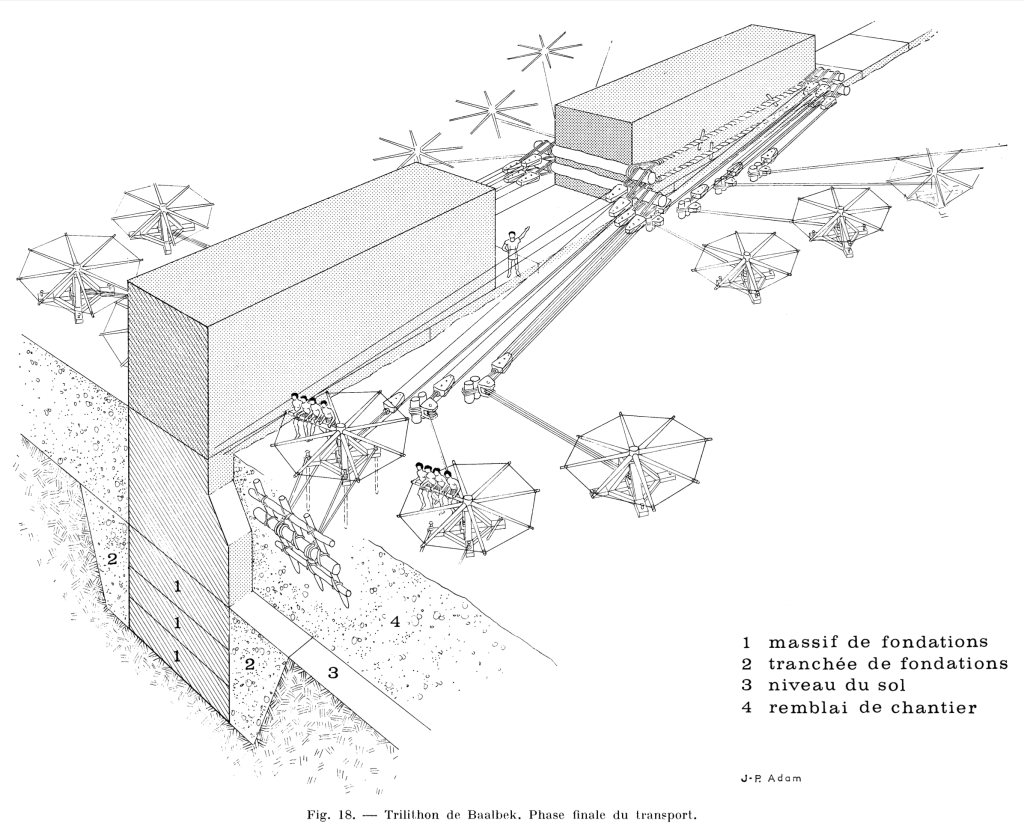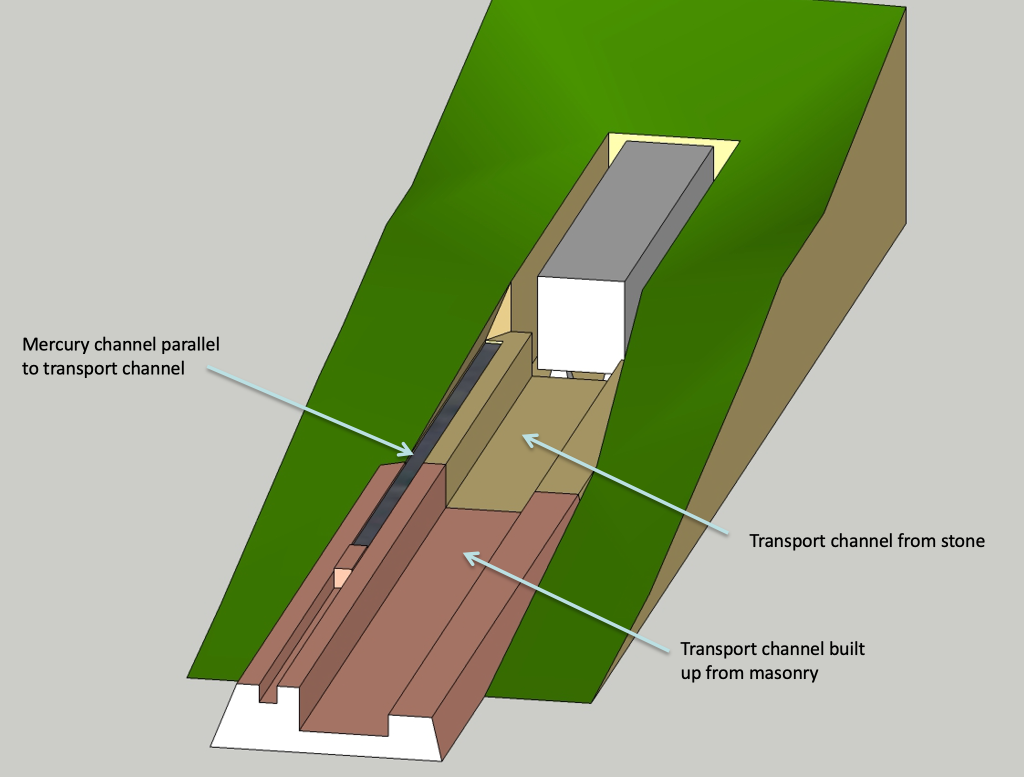A few years ago, I ran across a photo showing the trilithon in Baalbek, Lebanon. Three stones were moved onto a stone podium, and these limestones measured about 4m x 4m x 20m, and each weighed 800 tons. Current thinking seems to place the work in Roman times. How were these stones transported and put in place? Good question for the construction / engineering / building science community.

Jean-Pierre Adam, a French archaeologist, architect and professor, published a 1977 paper that provides a plausible method, using capstans.1 Prof. Adam showed the movement of later megaliths—St. Petersburg, the Vatican, and the Mussolini memorial—that were handled as he described. Still, I was not satisfied that transport was explained to my satisfaction.

It struck me to be in violation of construction rules that I’ve held to.
- Materials should be handled with a lightness of touch in proportion to the finishing of the material. This seems too rough for final placement.
- You never save the hardest or riskiest part for last, because it engenders frustration for all prior effort. Here, the closer to final placement, the greater the friction (rollers are gone) with lessened control.
- You must always have a well-defined fixed condition of placement, never allowing yourself to be in the position of having to settle for close-enough because of some aggravating last-minute impediment.
In 2013, Aaron Adair published an excellent update. It draws attention to a larger stone, the Stone of the Pregnant Woman, which sits tilted nearby, an obvious transportation failure. (Later work by German teams has identified two even larger stones that have been quarried but never moved.) Adair points out that the elevation of the quarry and the elevation of the podium on which the stones rest are essentially the same. He suggests possibly using a canal, but notes that somehow floating the stone “is not the most probable solution”.
Irrigation using canals is one of the well-established characteristics of early cultures. Canals even seem to be part of the worksites of monument-building. This was true of the pyramids of Giza. Canals connected Angkor Wat with the source of stone 50 km away. Building science studies the role of fluids in construction—air, water, and if we can harken back to the days of Carnot, heat—so this problem seems right up our alley. We know that cultures from the early Bronze Age up through the Roman times mastered several skills, which perhaps can be put to use to move giant stones. These include irrigation, canal-building, masonry, brick-making, smelting, quarrying, mining, textiles, dyes, trade, and many more. We are excluding anything extraterrestrial, though it is amazing how often their mention shows up in the popular literature. And then it hit me…
Gold.
Gold was processed and used and treasured from the very earliest days of metalwork. I encountered a jar with a gold plate rim and handle in the Louvre dating from the third millennium BC. Gold is an element which is found in elemental form on the earth’s surface. But the importance of gold in every culture argues strongly that gold processing was well-developed. We see in Egyptian images and figures that textiles were vividly colored. One common color was vermilion red. The source of vermilion dye is cinnabar, the ore of mercury sulfide. The processing of gold requires isolating gold from ore by the formation of a mercury amalgam, from which the gold is purified. They no doubt had, and used, mercury for gold processing.
Did they float the stones on mercury?
To extract mercury requires the use of an alembic or retort, a primitive distillation method. The cinnabar ore might have been crushed and placed in an alembic. The mercury would evaporate as a gas, leaving the sulfur and impurities as a mass at the bottom. The snout of an alembic is much shorter than the coils we use in distillation, so the gas must have been blown into some water chamber where it could condense into liquid mercury and be collected at the bottom. The same equipment would have been used for purifying gold by evaporating the mercury from the gold-mercury amalgam.

Mercury has a density of 13.69 grams per cc, or Tons per m3. The density of limestone is, let’s say, 2.68 T / m3. (assumed 800T mass divided by the actual dimensions). So the stone will float in a pool of mercury with about 1/5 of its mass below the surface.
First, we need to loosen the stone from its placement in the quarry. See the figures below. Workers would need to carve down the four sides of the stone, and then carve and remove stone from beneath, leaving the stone suspended on a minimum number of supports. Then it must be lifted off its supports. To do this, space may be filled with masonry. The joints would have to be tight, and the surface would have to be made tight against the entry of mercury—otherwise the masonry would just float away. Perhaps they used bitumen for this purpose.



They would also need to construct very strong masonry walls to resist outward thrust. We are accustomed to laying masonry in horizontal courses, and relying on the mortar to resist lateral shear forces. That would not work here, and, it appears, mortar use itself was quite rare. Is it possible to lay masonry in a 3-D mass such that there are no shear planes? Here is a set of diagrams showing that masonry elements with dimensions of 1 x 1 x 2 can be laid in 3 dimensional herringbone fashion, so that the space is completely filled, and all three directions have masonry elements interrupting their planar continuity.




Once the carving is done and the space is filled and protected from the mercury, then mercury can be used to lift the stone from its supports. If the stone is lying immersed completely in a mercury bath, and if, say, the downward weight is 800T, then the upward buoyancy would be up to 5 times greater or 4000T of upward force working on the stone. I think that might work to crack it from its supports.

Then the stone must move along a canal to the podium. The canal need not be continuous, because the stone was probably moved in increments. The canal sides would be 1/5 of the height of the stone, and protected from mercury leakage (which would otherwise lift the masonry sides and the mercury would be lost). Masonry barriers would be put in place for the length of the transport increment. With the blockage in place, the canal segment would be filled, the stone moved the incremental length, then the mercury would be drained and the barriers moved for the next transport segment.

One nice thing about this means of transport is that the underside of the stone can be smoothed. If a canal segment is provided with a churt or flint abrasive surface, embedded in bitumen, the height of the stone above the abrasive can be regulated by the amount of mercury, and the stone can be moved back and forth with little or no effort until the bottom is satisfactorily smooth.

If the path of the stone is strictly horizontal without elevation changes, then the mercury amounts needed are small, depending on the length of a travel segment. Considerably more mercury is required for changes in height.

I have no idea how these stones were actually transported. I have sought here to provide a novel possibility for transport which meets my three construction rules above, and which I hope might merit consideration. I sincerely welcome feedback. I have only amateur interest in archaeology. But I have a professional top-level interest in the role of fluids in building construction and performance.
We have still not answered why they brought megaliths of such dimension into their construction. There’s an outside chance, very unlikely, that their reason for moving gargantuan stones like this is because they were lazy. Quarrying one big stone requires less work than quarrying many smaller stones, if the carving / removal process is similar in the two cases. Once the canal is in place and mercury-leak-proofed, and once there were giant urns filled with, say, three or four cubic meters of distilled mercury ready for use, then you or I could push an 800 ton stone for the length of the travel segment without breaking a sweat. And the moving process would be of a very refined delicacy, meeting rule number one. I can just picture a monarch smiling on a Sunday afternoon conducting a ritual moving of the megalith as the community stands in awe of royal power, with the canal builders and mercury schleppers slightly less impressed.
Footnote
- Jean-Pierre Adam, 1977, À propos du trilithon de Baalbek: Le transport et la mise en œuvre des megaliths (in French). Syria. T. 54, Fasc. 1/2 (1977), pp. 31-63 (35 pages). https://www.jstor.org/stable/4198097

Leave a comment